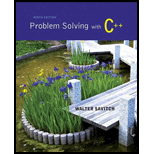
Problem Solving with C++ (9th Edition)
9th Edition
ISBN: 9780133591743
Author: Walter Savitch
Publisher: PEARSON
expand_more
expand_more
format_list_bulleted
Question
Chapter 1.1, Problem 11STE
Program Plan Intro
Computer Systems:
- A computer denotes a machine or device that would accomplish processes, computations as well as operations centered on instructions provided by software.
- A computer follows an instruction set that is termed as a
program . - The collection of programs used by computer is termed as software.
- The computer installation is made up by physical machines termed as hardware.
Linking:
- Linking denotes a process that combines all component object files.
- Linker determines position of code in memory.
- It denotes method to control transfer between components.
- It takes one or more object files created by compiler and combine them into single executable file.
- The resolution of undefined symbols is deferred until a program is run and it’s termed as dynamic linking.
- The libraries that are often-used required to be stored in single location.
- It is not duplicated in all single executable files.
- If a bug in a function is been corrected by replacing library, all of the programs will benefit from this linking.
- A static linking denotes copying of all routines used in program into executable image by linker.
- It requires more space and memory than dynamic linking.
- It denotes more portability.
- Each program includes exactly required versions of its library routines.
- The entire library may not be required in many cases.
- A linkage editor allows replacement, addition and deletion of sections of individual programs.
Expert Solution & Answer
Want to see the full answer?
Check out a sample textbook solution
Students have asked these similar questions
Using R language
using r language
using r language
Chapter 1 Solutions
Problem Solving with C++ (9th Edition)
Ch. 1.1 - Prob. 1STECh. 1.1 - What would be the data for a program to add two...Ch. 1.1 - Prob. 3STECh. 1.1 - What is the difference between a machine-language...Ch. 1.1 - What is the role of a compiler?Ch. 1.1 - What is a source program? What is an object...Ch. 1.1 - What is an operating system?Ch. 1.1 - What purpose does the operating system serve?Ch. 1.1 - Prob. 9STECh. 1.1 - Prob. 10STE
Ch. 1.1 - Prob. 11STECh. 1.2 - An algorithm is approximately the same thing as a...Ch. 1.2 - Prob. 13STECh. 1.2 - Prob. 14STECh. 1.2 - Prob. 15STECh. 1.3 - If the following statement were used in a C++...Ch. 1.3 - What is the meaning of \n as used in the following...Ch. 1.3 - What is the meaning of the following statement...Ch. 1.3 - What is the meaning of the following statement...Ch. 1.3 - What is the meaning of this directive? # include...Ch. 1.3 - What, if anything, is wrong with the following...Ch. 1.4 - Prob. 22STECh. 1.4 - Prob. 23STECh. 1.4 - If you omit a punctuation symbol (such as a...Ch. 1.4 - Omitting the final brace } from a program produces...Ch. 1.4 - Prob. 26STECh. 1.4 - Suppose you write a program that is supposed to...Ch. 1 - Using your text editor, enter (that is, type in)...Ch. 1 - Modify the C++ program you entered in Practice...Ch. 1 - Further modify the C++ program that you already...Ch. 1 - Modify the C++ program that you entered in...Ch. 1 - Modify the C++ program that you entered in...Ch. 1 - Prob. 6PCh. 1 - Write a C++ program that reads in two integers and...Ch. 1 - Write a program that prints out C S ! in large...Ch. 1 - Write a program that allows the user to enter a...Ch. 1 - Write a program that allows the user to enter a...Ch. 1 - Write a program that inputs a character from the...
Knowledge Booster
Similar questions
- I need help in explaining how I can demonstrate how the Laplace & Inverse transformations behaves in MATLAB transformation (ex: LIke in graph or something else)arrow_forwardYou have made the Web solution with Node.js. please let me know what problems and benefits I would experience while making the Web solution here, as compared to any other Web solution you have developed in the past. what problems and benefits/things to keep in mind as someone just learningarrow_forwardPHP is the server-side scripting language. MySQL is used with PHP to store all the data. EXPLAIN in details how to install and run the PHP/MySQL on your computer. List the issues and challenges I may encounter while making this set-up? why I asked: I currently have issues logging into http://localhost/phpmyadmin/ and I tried using the command prompt in administrator to reset the password but I got the error LOCALHOST PORT not found.arrow_forward
arrow_back_ios
SEE MORE QUESTIONS
arrow_forward_ios
Recommended textbooks for you
- Np Ms Office 365/Excel 2016 I NtermedComputer ScienceISBN:9781337508841Author:CareyPublisher:Cengage
 C++ for Engineers and ScientistsComputer ScienceISBN:9781133187844Author:Bronson, Gary J.Publisher:Course Technology Ptr
C++ for Engineers and ScientistsComputer ScienceISBN:9781133187844Author:Bronson, Gary J.Publisher:Course Technology Ptr - COMPREHENSIVE MICROSOFT OFFICE 365 EXCEComputer ScienceISBN:9780357392676Author:FREUND, StevenPublisher:CENGAGE L
 C++ Programming: From Problem Analysis to Program...Computer ScienceISBN:9781337102087Author:D. S. MalikPublisher:Cengage Learning
C++ Programming: From Problem Analysis to Program...Computer ScienceISBN:9781337102087Author:D. S. MalikPublisher:Cengage Learning EBK JAVA PROGRAMMINGComputer ScienceISBN:9781337671385Author:FARRELLPublisher:CENGAGE LEARNING - CONSIGNMENT
EBK JAVA PROGRAMMINGComputer ScienceISBN:9781337671385Author:FARRELLPublisher:CENGAGE LEARNING - CONSIGNMENT

Np Ms Office 365/Excel 2016 I Ntermed
Computer Science
ISBN:9781337508841
Author:Carey
Publisher:Cengage

C++ for Engineers and Scientists
Computer Science
ISBN:9781133187844
Author:Bronson, Gary J.
Publisher:Course Technology Ptr


COMPREHENSIVE MICROSOFT OFFICE 365 EXCE
Computer Science
ISBN:9780357392676
Author:FREUND, Steven
Publisher:CENGAGE L

C++ Programming: From Problem Analysis to Program...
Computer Science
ISBN:9781337102087
Author:D. S. Malik
Publisher:Cengage Learning

EBK JAVA PROGRAMMING
Computer Science
ISBN:9781337671385
Author:FARRELL
Publisher:CENGAGE LEARNING - CONSIGNMENT